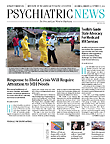National suicide prevention strategies, better surveillance, and restricting access to lethal means should be at the core of a worldwide approach to preventing suicide, according to a report issued in September by the World Health Organization (WHO).
“The report aims to increase the awareness of the public health significance of suicide and suicide attempts and to make suicide prevention a higher priority on the global public health agenda,” wrote Shekhar Saxena, M.D., director of WHO’s Department of Mental Health and Substance Abuse, and Etienne Krug, M.D., M.P.H., director of the Department of Violence and Injury Prevention and Disability, in the preface to the 92-page report.
“This is a well-timed statement by the WHO regarding its concern about suicide as an important contributor to morbidity and mortality,” said APA Secretary Maria Oquendo, M.D., a professor of clinical psychiatry at Columbia University, in an interview. “There are a number of initiatives in the United States about suicide, which are long overdue.”
The WHO report suggested that governments create national suicide prevention strategies to reduce the incidence of suicide. The U.S. surgeon general issued such a plan in 2012, in cooperation with the National Alliance for Suicide Prevention.
The report noted that more than 800,000 people around the world die due to suicide each year, of which 75 percent occur in low- or middle-income countries.
Prevention demands “a comprehensive, multisectorial” strategy because the risk is determined not only by individual factors, but by social, community, and health system factors.
All substance use disorders increase the risk of suicide, but 1 in 5 suicide deaths can be attributed to the use of alcohol, the report emphasized. Legal, social, and economic measures should be strengthened to lessen the harmful use of alcohol.
In Europe, the use of prescription medications to die by suicide is common, so restricting availability to those drugs and educating patients and their families about their dangers may prove useful.
Cultural matters play a role in suicide, too, said Oquendo. Some societies stigmatize mental illness and the decision to seek mental health care.
“The status of women in some countries, like China, contributes to their higher suicide rates,” she said. “However, many countries in Latin America or southern Europe with Catholic traditions have lower than expected suicide rates.”
The report suggested several areas of potential interventions to reduce suicide. “[C]omprehensive, integrated, and responsive mental health and social care services” are needed, along with access to general medical care in community-based settings.
Restricting access to means of suicide is another preventive measure. Access to firearms is a familiar and controversial topic in the United States. However, one-third of suicides worldwide are attributable to pesticides, especially in rural areas of low- and middle-income countries in Africa, Southeast Asia, Central America, and the Western Pacific. Regulations on the sale, storage, use, and toxicity of pesticides might lessen the dangers of their use for suicide, said the report.
“The more lethal the means, the less chance of rescue, especially in areas where medical care is hard to reach quickly,” said Oquendo.
Social measures like destigmatizing mental illness and help-seeking may have longer-term value. The WHO report also suggests a role for “gatekeepers”: a person who might be trained “to identify whether someone may be contemplating suicide.” Gatekeepers might be teachers, health providers, police, or religious leaders, among others.
One significant aspect of the report is that it defines “suicide attempt” as any self-injury, regardless of intent to die, said Oquendo.
“This is a more expansive definition of suicidal behavior than that used in the U.S. by the National Institute of Mental Health, the Centers for Disease Control and Prevention, and the Food and Drug Administration,” she said. “There are not only important differences in the expression of suicidal behavior with and without the intent to die, but also differences in the appropriate medical intervention in the emergency department.”
Oquendo noted that 5 percent to 10 percent of people who die by suicide do not have an identified psychiatric disorder.
“This begs the question of whether we may need a different way of identifying suicidal behavior, perhaps as a separate diagnosis, something unto its own, rather than as a symptom of depression or borderline personality disorder, even though we know it happens in the presence of schizophrenia or alcoholism or posttraumatic stress disorder,” said Oquendo.
“This report, the first WHO publication of its kind, presents a comprehensive overview of suicide, suicide attempts, and successful suicide prevention efforts worldwide,” said Saxena in a statement. “We know what works. Now is the time to act.” ■
“Preventing Suicide: A Global Imperative” can be accessed
here. The U.S. Surgeon General’s “2012 National Strategy for Suicide Prevention” is available
here.
